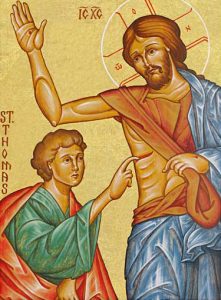


The Throne of St. Thomas
The concept of the 'Throne of St. Thomas' is based on the words of our Lord Himself. In St. Mathew 19:28 it is written that ‘Jesus said to them: Amen, I say to you, you who have followed me, when the Son of Man is seated on the throne of his glory in the rebirth, you yourselves shall also sit upon twelve thrones ruling the twelve tribes of Israel’’. In Luke 22:28 our Lord says to the twelve "You are those who have continued with me in trials. As my father appointed a Kingdom for me, so do I appoint for you that you may eat and drink at my table in my Kingdom, and sit on thrones judging the twelve tribes of Israel".
From these two passages it is quite clear that our Lord promised twelve thrones to the twelve apostles and none of them was deprived of having the authority. Even Judas Iscariot was promised a throne, but he fell from his honor and another inherited his place. If the Twelve have thrones, then there can be no doubt at all that St. Thomas the Apostle had also a throne.
The word ‘throne’ is derived from the Greek word ‘Thronos’ and the Syriac equivalent is ‘kursyo’. In Hebrew it is ‘kisse’. The word primarily means ‘the seat of authority of a king or a prince or a judge. Both in Old Testament and in New Testament the word throne is referred to the seat of authority (cf. 1 kings 22:19; Issah 6:1; Sam 4:1-13 etc.). In Revelation 4:2 we see a throne in heaven which is the seat of God and in 4:4 we see twenty four other thrones set around the throne of God. 24 elders were seated on the 24 thrones (4:4), clad in white garments and with a golden crown on the head of each. The tradition of the Church says that the 24 elders are the 12 tribal patriarchs of the Old Testament and the 12 Apostles of the New Testament (Rev. 11:6). Thus by the word ‘throne’ it means the ‘authority proceeds from God bestowed up on disciples.
The following assumptions can be drawn from the analysis of the above biblical passages: The throne is the seat and symbol of authority and is primarily applied to the highest of all authorities from whom every authority comes, ie., the authority of God and therefore the Throne of God. In the Scriptural accounts the throne of God is shared by Jesus Christ who sits at the right hand of God the Father. He is ruler and the judge.
Jesus Christ shares his throne with others. In the book Revelation 24 elders share it with him. Jesus promises twelve thrones to the twelve apostles. There is no indication in the Bible that the authority is exclusively for any one of the disciples. It is a common heritage and privilege. In this matter of throne, there is no difference between the authority vested on St. Peter and St. Thomas. In the tradition of the Church also we do not hear very much of the thrones of particular apostles; rather apostolic thrones are shared by all the bishops. Every bishop succeeds to the Apostolic thrones of the whole college of Apostles.
During the course of the time, the word ‘throne’ gradually gave place to other Greek word for the seat of authority ‘kathedra’. It is used in Mathew 23:2 for the seat of Moses or the place of the teaching authority of the Mosaic Law. The word ‘Cathedral’ comes from ‘kathedra’ which in Christian use means a bishop’s chair. A cathedral is not simply a large church, but a church which has the bishop’s throne in it as s symbol of authority or ‘throne’. Every bishop possesses the authority given by the Church and for the Church. No bishop has any authority independent of the Church; it is the authority of the Church that they exercise in the Church.
(The above article is prepared by H.G. Dr. Zachariah mar Aprem based on a paper submitted by Late lamented Metropolitan Dr. Paulose Mar Gregorios to the Holy Episcopal Synod in 1974)